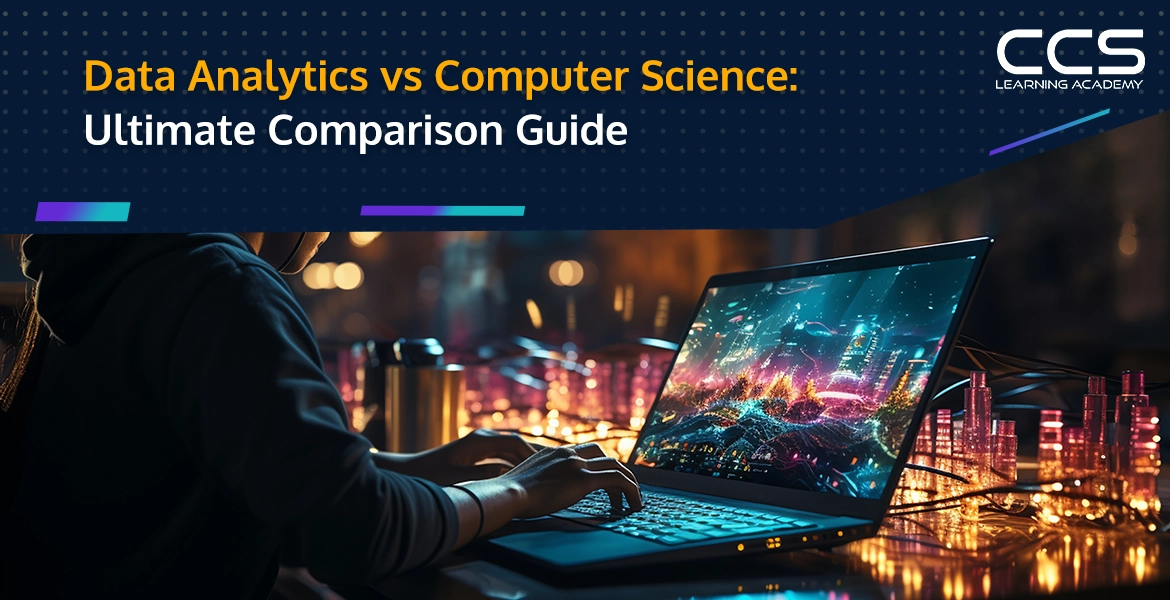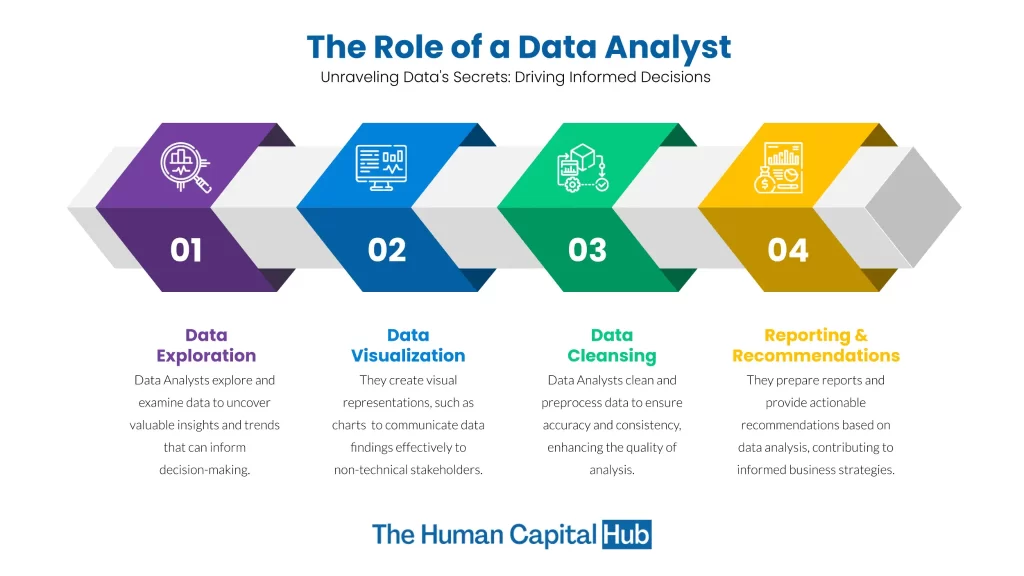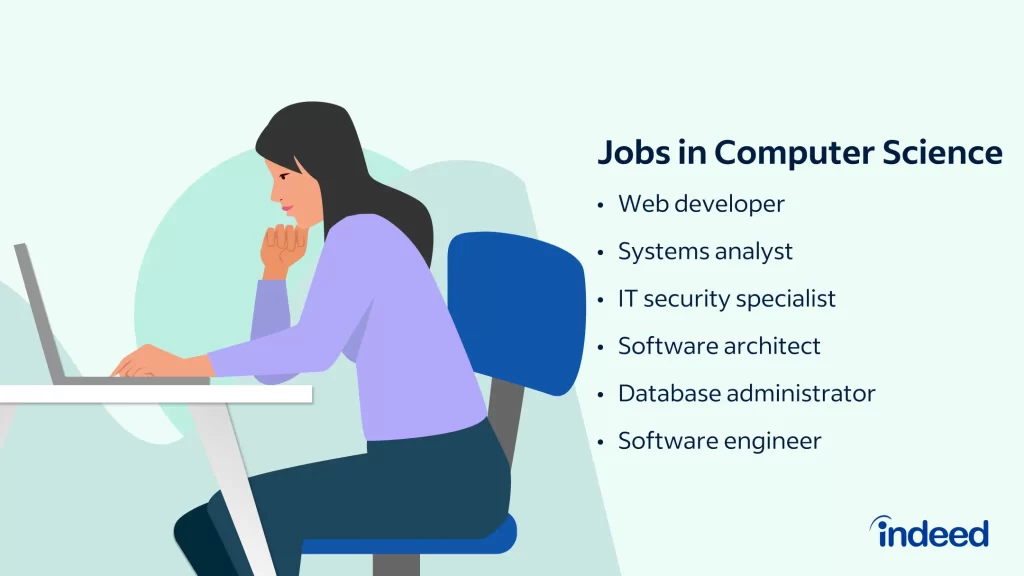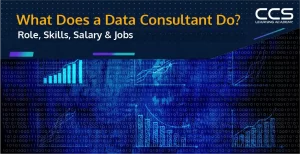Data Analytics vs Computer Science: Ultimate Comparison Guide
- -
- Time -

Data analytics and computer science are two different fields with different skill sets, responsibilities, career paths, and educational criteria. Data analysts work on data analytics and visualization, while computer science involves developing software and applications. Both of these are the hottest career options for technology professionals.
With data available in every industry and computer power, both fields offer a great opportunity and job prospects to professionals. The growth of the tech sector has fueled the significance of data analytics and computer science in today’s world. These fields drive decision-making and success in various industries.
Data analytics involves techniques to conclude data, while computer science needs programming, technical writing, and business skills. Professional degrees, certifications, networking, and skill sets can improve your chances of growing and succeeding.
In the last few years, the demand for data analytics and computer science has been increasing. To understand these concepts better, let’s know the key differences between data analytics vs. computer science.
Table of Contents
- Understanding Data Analytics
- Process Followed in Data Analytics
- Roles and Responsibilities: Data Analytics
- Understanding Computer Science
- Roles and Responsibilities: Computer Science
- Comparative Table: Data Analytics vs. Computer Science
- How to Begin a Career in Data Analytics?
- How to Begin a Career in Computer Science?
- Applications of Data Analytics
- Applications of Computer Science
- Bottom Line
- FAQs
Understanding Data Analytics
Data analytics refers to the set of methods and techniques that are implemented to derive meaningful conclusions from raw data. This is done with in-depth analysis of data and this process enables the analysts to detect metrics and patterns. Furthermore, there are three types of data analytics processes that an analyst follows. These are as follows:
#1. Descriptive Analytics
In descriptive analytics, analysts usually answer the what and why part of the problem. It solves the business problem with data-driven solutions. This analytical process provides actionable insights using historical data, patterns, and trends.
#2. Predictive Analytics
This analytical process provides a solution by employing machine learning models to ascertain future trends using past data. The probability of cross-selling a product to the customer is done using predictive analysis based on historical engagement data.
#3. Prescriptive Analytics
Prescriptive analytics uses the conclusions of descriptive and predictive analytics to formulate business strategies again. These strategies are better structured and are prepared based on historical data and by analyzing the probability of cross-selling. This way, any business can identify the best product mix for their target audience using prescriptive analytics.
Process Followed in Data Analytics
A data analyst follows a process that allows them to obtain valuable information and make data-driven decisions. Here is the process followed by them:
#1. Data Extraction
Data extraction is the step where an analyst extracts data from the primary source. It is limited to smaller datasets.
#2. Data Cleaning
Once the data is extracted, it is processed and summarized in different visualizations, which intuitively highlight emerging trends, anomalies, and facts.
#3. Data Exploration
The data exploration stage allows us to explore the reasons behind current trends and anomalies. In this stage, useful datasets are analyzed and studied to derive something new.
#4. Data Visualization and Reporting
Visualization is the last stage, where analysts prepare intuitive dashboards and reports for business documentaries and share valuable insights from them with stakeholders. Commonly, self-serving business intelligence tools like Power BI and Tableau are used for visualization and reporting purposes.
Roles and Responsibilities: Data Analytics
To have a better understanding of data analytics vs computer science, you must understand the key roles and responsibilities of data analysts and scientists who work in the data analytical field.

Here are some major responsibilities:
- They mine large datasets to identify and uncover hidden patterns and draw insights based on them.
- They clean up messy data and process it to mine meaningful insights and use them in the decision-making process.
- Facilitates building predictive models and machine learning algorithms for making necessary predictions and recommendations.
- The analysts forecast future trends and outcomes of the organizations.
- Communicate data-driven insights to stakeholders and ensure it is being used efficiently.
Understanding Computer Science
Computer science is a field that deals with computers and computational systems. It follows a scientific and practical approach to the implementation and application of computer systems. Furthermore, computer science principles and theories act as rigid building blocks that are used to perform complex tasks like coding.
Computer science has branched out into many specialized fields like computer graphics, computer vision, software engineering, and human-computer interaction.
Roles and Responsibilities: Computer Science
In computer science, scientists usually work on technology, but there are certain key responsibilities too which they follow. Understand data analytics and computer science to clarify the difference between them.

Here are some important roles played by professionals in the computer science field:
- They design, develop, and optimize software applications and systems with different codes and frameworks.
- The scientists collaborate with users and stakeholders to fully understand the requirements.
- They write efficient coding to bring the designs and ideas to life in programs and apps.
- Software is tested to check if there are any bugs or flaws before the release of the product.
- It involves cleverly devising test cases to break the code and uncover weak points.
- Strengthens the performance of the software by boosting the speed and refactoring code.
- Provides technical support and troubleshooting to solve any issues or bugs. This digs out codes or data to identify the root cause of the problem.
- Researches new ways to integrate software development. This requires cutting-edge technology updates in computer science.
Comparative Table: Data Analytics vs. Computer Science
| Basis | Data Analytics | Computer Science |
|---|---|---|
| Definition | Data analytics refers to the set of techniques that are implemented to derive meaningful conclusions from raw data. | Computer science is a field that deals with computers and computational systems. It follows a scientific and practical approach to the implementation and application of computer systems. |
| Scope | Narrow scope with fewer career paths. | Wide scope with many possible career paths. |
| Area to focus | Focus on mainly statistical and analytical concepts to extract useful intelligence. | Develops models that enable smooth interaction between humans and devices. |
| Goals | Detects the trends and patterns to support the decision-making. | Boosts technical growth and contributes to the development of intelligent systems. |
| Goals | Detects the trends and patterns to support the decision-making. | Boosts technical growth and contributes to the development of intelligent systems. |
| Education level | Mainly opted after the post-graduation level. However, one can study after an undergraduation and get a certification. | Offered at all levels of higher education. Certification course boosts the level further. |
| Approach | Statistical approach | Computational approach |
| Advantages | Arrange and derive valuable trends from a huge amount of dataset without any loss. | Boosts speed and efficiency. |
| Salary and job outlook | Average annual salary – $72,945 | Average annual salary – $72,173 |
| Core skill set | * Critical thinking * Business understanding * Data management * Programming * Statistics | * Mathematics * Technical coding * Programming * Computer & technology * Software development |
| Possible job titles | * Data analysts * Data scientists * Data engineers * Business data analysts | * Networking engineer * Software engineer * Web developer * Game developer * Game designer * UX designer * App Developer |
| Tools used | * Knime * RapidMiner * Heap * Typeform * Amazon Redshift | * PowerPoint * Linux command * Text editor * Excel * PowerShell |
| Applications | It is used in large and small-scale data-driven organizations in the following sectors: *Risk detection *Digital ads *Security *Healthcare | Used in technical organizations in the following sectors: * Banking * Business * Governance * Healthcare * Entertainment |
How to Begin a Career in Data Analytics?
To begin your career in data analytics, follow the below-given points:
- Earn a relevant degree, whether undergraduation or postgraduation. Give more emphasis on analytical and statistical papers and skills.
- Study the industry and understand different aspects and roles available within the industry. Define your niche and work towards that by brushing up your skills.
- Develop in-demand and highly preferred skills, both technical and soft. Follow the latest trends in the industry and keep track of them.
- Learn coding as it will help in future work. Be proficient in analyzing big datasets and writing and analyzing codes.
- Get familiar with tools and in-demand technological software to excel in your field and ace the interview with such knowledge.
- Furthermore, a professional certification adds huge points to your CV and career options. You can go for CompTIA Data+ certification to get extensive knowledge of data analytics.
- The network is the most important element. Networking allows you to be in trend and helps you at times of need. It provides lots of opportunities in front of you, and referrals might help you in the near future.
How to Begin a Career in Computer Science?
If you need clarification on what to choose, data analytics or computer science, you should first be fully aware of the different aspects of both fields.
To know how to start your career in computer science, go through the following points:
- Choose a relevant degree. Computer science has many subfields that can interrelate sometimes.
- If you have a particular type of skill, brush up on those and excel in each domain, depending on your aptitude and abilities.
- If you have a master’s degree, you don’t have to settle for entry-level jobs. You can simply get a certification degree like Python Foundations eLearning to brush up on your technical skills. These certifications will boost your career options and will offer you more responsible titles.
- Develop in-demand skills that are often preferred by recruiters and keep up with the trends. To stay employable, you need to stay updated with the latest trends and skills, especially technology.
- Keep your resume updated and shed enough light on your resourceful experiences in your resume.
- Build a network. Networking is what you need to widen the prospect of opportunities. With a good and wide network, you can access multiple opportunities and be employable in higher positions with handsome salary options.
Applications of Data Analytics
Data analytics is a field with lots of opportunities as it is applicable in various sectors and industries. Know these applications to understand major differences in data analytics and computer science.
Some of the primary sectors where data analytics is applicable are as follows:
#1. Risk Detection
Data analytics allows you to detect any fraudulent activities and risks. It is one of the best methods to manage expenses, examine customer profiles, and analyze any potential cyber threats.
#2. Digital Ads
The digital ads allow you to keep a check on your devices. It intervenes in digital analytical techniques, and the ad creator uses analytics to track customer behavior and plug-in ads. These digital ads are implemented in the form of impressive click-through rates or pay-per-click strategies.
#3. Security
Data analytics is used in security forces to keep cities away from crime. Especially when it is cybercrime, security is needed at most. The police tap into geographical and historical data of the devices, and with just a single click, they can find out the crime footage or evidence. Backup and restore options help in preventing cyber crime implications.
Applications of Computer Science
In the computer science field, many major areas apply computer science concepts to ease their work and make the most use of it.
Here are some places that use the application of computer science:
#1. Banking
Automated account management, UPI, and centralized database systems have revolutionized the banking sector. It has made customer transactions easy and enables fair business operations.
#2. Businesses
Companies are making use of computer science in multiple ways. The IT department of businesses uses computer science to establish security and cyber tactics to secure business transactions and data. Online companies are running on the base established using computer science. Actual stores are computerizing their billing process using computer science.
#3. Medicines
The most remarkable social impact of computer science is on the medicinal and healthcare fields. Medical imaging, MRI, and diagnosis processes have been revolutionized since the advent of computer science. The central hospital information system has a prominent application of computer science too.
Bottom Line
Both data analytics and computer science are different, but they both work extensively on data. The major point on data analytics vs computer science is that they both have various applications and uses. The level of programming used in both is different. Data analytics requires more data, while computer science needs the highest level of programming ability. Though the salaries in both these industries are somewhat the same, the roles and responsibilities differ. You can choose any of these fields depending on your skills, educational background, and interest.
If you want to know where you can access the certification courses and programs, you can join the Data Analytics & Engineering Bootcamp of CCSLA. This will provide hands-on experience on the latest trendy projects and also will give you job placement assistance. Try out this bootcamp program and get numerous benefits and build up your CV to land a deserving job.
FAQs
Data Analytics involves the process of examining data sets to conclude about the information they contain. It employs various techniques and tools to identify trends, patterns, and relationships within data, which organizations can use to optimize their performance.
Computer Science is the study of computers and computational systems. It primarily focuses on software, software systems, and their development. It encompasses theoretical studies of algorithms and the practical challenges of implementing them through computer software and hardware.
The main objective of Data Analytics is to derive actionable insights from data, which can help in decision-making and strategic planning. Computer Science, on the other hand, aims at creating and managing software applications, system software, and hardware processes that drive computational machines.
Typical job roles in Data Analytics include Data Analyst, Data Scientist, Business Intelligence Analyst, and Data Analytics Consultant. In Computer Science, typical roles include Software Developer, Systems Architect, Software Engineer, and Network Administrator.
Careers in Data Analytics require strong statistical analysis skills, proficiency in tools like SQL, Python, R, and data visualization tools, along with an ability to interpret and communicate data findings effectively.
Computer Science careers typically require strong programming skills in languages such as Java, C++, Python, or Ruby, a deep understanding of algorithms and data structures, as well as knowledge of database management, computer hardware, and software environments.
Educational paths for Data Analytics often include degrees in statistics, mathematics, or data analytics, which focus on quantitative skills and the application of these skills to business decisions. Computer Science degrees focus on software development, computational theory, and the hardware-software interface.
Data Analytics is more suitable for those interested in working directly with data to extract insights, predict trends, and help guide business decisions. It’s ideal for those who enjoy statistical analysis and data interpretation.
In Data Analytics, emerging trends include the use of Artificial Intelligence and Machine Learning for predictive analytics, and real-time data processing. In Computer Science, trends include developments in quantum computing, blockchain technology, and the growing importance of cloud computing.
Yes, professionals in Computer Science can switch to Data Analytics, especially those who have experience in algorithm development and programming, as these skills are highly transferable. Conversely, Data Analysts with strong programming skills and a solid understanding of algorithms and databases can transition into Computer Science roles.






